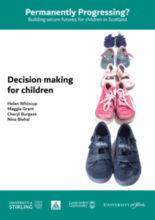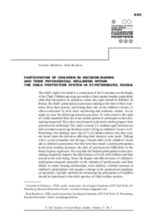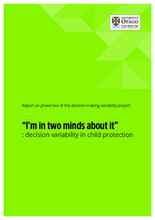Displaying 21 - 30 of 191
This article reports on a qualitative study, which sought to retrospectively understand the contribution family group conferencing (FGC) makes to longer‐term outcomes for children at risk of entering State care and their families.
The Decision making for children report is one strand of the Permanently Progressing? study. In this strand, during 2015-17, 160 decision makers were interviewed across Scotland mainly in groups, but some individually.
The primary aim of this study is to summarise research findings about the use of assessment frameworks, that is, structured models that guide information collection and decision making in child protection services, by reviewing the literature.
In order to gain insight into the role that decision-making plays in family preservation practice, the authors of this article studied decision-making within a family preservation (FP)-intervention program provided by the Expertise Center.
This short human rights in action article takes a critical approach to the translation of policy to practice and highlights risks involved with haste, outcomes measured in numbers and unrealistic timeframes, and rapidly transforming practice with nascent investment in a country’s capacity to assess and respond to the real needs of children and families within their communities.
This study raised the following research questions: To what extent is the right of a child separated from his or her natural parents to participate in decisionmaking respected? How does involvement in decision-making impact their psychosocial wellbeing?
Decisions in the child protection context take place in a complex environment influenced by individual decision-makers, institutional resources and practices, demographic inequalities, and family responses. This report describes some of these factors as reported by practitioners in the child protection context in Aotearoa New Zealand, providing an insight into the experiences and perceptions of front-line practitioners.
This chapter from the book Modern Day Slavery and Orphanage Tourism highlights promising practice which aims to prevent and reduce the institutionalization of children at two levels: (1) systems and social work strengthening, and (2) family strengthening and gatekeeping.
Utilizing case examples, this discussion paper examines foster care decisions that disrupt important child-caregiver relationships.
In an explorative manner, the current study investigates variables that influence psychological evaluators’ recommendations in child protection cases.



